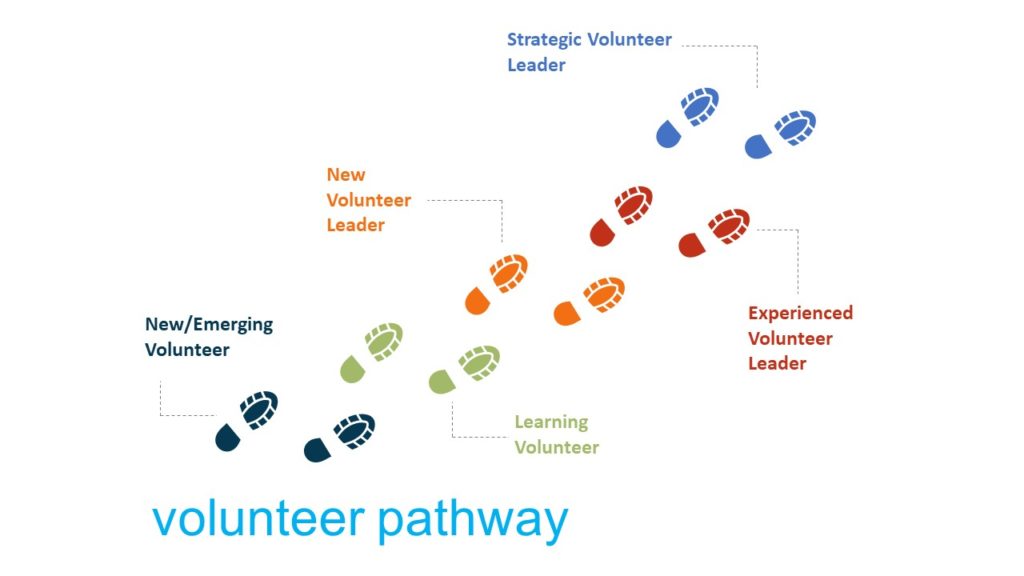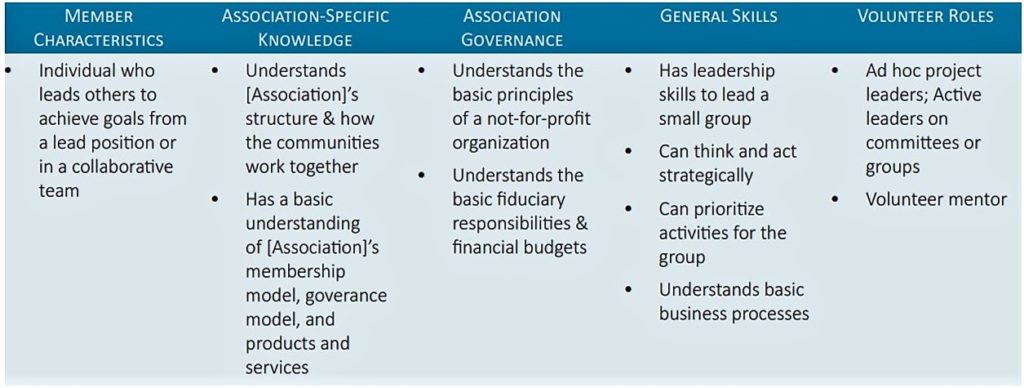*Part 2 of a 3-part series on creating a volunteer learning journey.
In the last post, we gave you an overview of how the volunteer learning journey concept was developed as well as how it can help your volunteers take charge of their training thus leading to more qualified volunteer leaders.
In this post, we’ll talk about how to begin building a volunteer matrix that taps into the diverse skills, knowledge and energy of your volunteers, and puts your volunteers into the driver seat of their own training.
To frame the approach, we can start by looking at the 5 basic learning and development levels identified by Mariner Management.
- Emerging or new volunteers are members who would like to contribute to the organization but likely have limited knowledge and skills in the four areas (institutional knowledge, association governance, leadership and project/role specific skills/knowledge).
- Learning volunteers have engaged in their first organized role within organization, working on a deliverable or on a team with a specific outcome to achieve. They are essentially your emerging leaders with a basic knowledge in the four areas.
- New volunteer leaders may chair a local, state or national taskforce, or serve as newly elected or appointed leaders of a chapter, Special Interest Group or Community of Practice, or lead a local or national project. They are essentially your developing leaders with good institutional knowledge, necessary association governance knowledge and at least basic leadership skills
- Experienced volunteer leaders are experienced leaders of components (chapters, SIGs etc.), big projects or new products that are in development. They aspire to lead a large, self-motivated group through strategic direction-setting. They have good institutional and association governance knowledge and strong leadership skills.
- Strategic volunteer leaders are elected or appointed. They may serve (or have served) on the Board of Directors, lead a mature community, or lead the development of a significant product or program. They have mastered the competencies of strategic leadership and play a large role in setting the organization’s direction. They fully understand the organization and the profession, have a full appreciation for the intricacies of nonprofit organizations, and have demonstrated strong leadership.
The levels reflect the typical member characteristics and the knowledge and skills needed to be successful in volunteer roles at that level. Within each level, we describe the needed institutional and association governance knowledge, the project-specific knowledge and leadership skills, and potential roles best suited to the volunteer. See example of New Volunteer Leader below.
Of course, the motivations for the volunteer at each level will vary and volunteers will move in and out depending on the current circumstances, but the matrix can serve as a guide as you begin to build your program.
Level 3 – New Volunteer Leader
The value of this approach is three-fold: For the volunteer, it takes the guess work out of what is required (i.e., competencies, prerequisites) for each opportunity, helps them identify additional training they may need as they move through the various levels, and lays out what is needed to be a successful leader if this is what they truly desire. Likewise, volunteer mentors and recruiters will be able offer current and prospective volunteers a clear sense of where they might get started and/or aspire to across the continuum of volunteer opportunities. And last but not least, it guides the association (that’s you) in developing training, resources, and onboarding and orientation materials.
It’s important to note here that finding what’s truly behind one’s motivations for volunteering and how to match these with the needs of the association is key to creating a successful program. To determine this, it’s important to not just ask what they want to do, but why they want to do it. This will help you adjust their training to meet their needs and in turn increase the volunteer’s willingness to learn as they become partners in determining their volunteer journey.
In our next post, we’ll talk about how you can map different scenarios to determine the right pathway for your volunteers, and some tips on putting the concept in action.
As always, we encourage you to download the toolkit developed by Peggy and Kristine* for more details and examples on building your program. Also download our free tip sheet Coaching Volunteer Leaders: Tips for Creating A 12-month Strategy.
And when you have some time, sit back and listen in on our June webinar where Peggy and Kristine first introduced the VLJ (you can get a quick recap of the webinar here) or read Sarah Garrity’s (Billhighway) 4-post series.
*This project was a collaboration between Peggy Hoffman, FASAE, CAE, president of Mariner Management and Kristine Metter, MS, CAE, president of Crystal Lake Partners, along with an advisory panel of CRPs.


